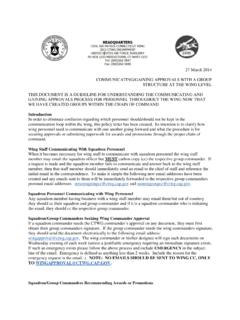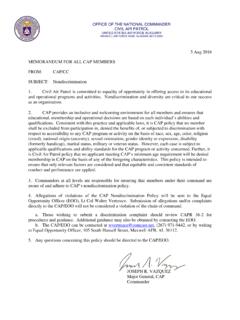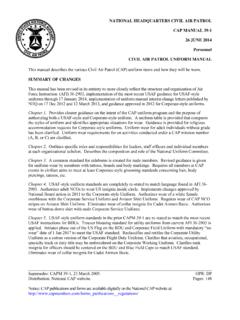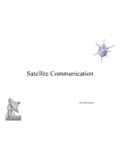Transcription of Aerospace Dimensions SPACECRAFT 6 - ctwg.cap.gov
1 Aerospace Dimensions SPACECRAFT . 6. MODULE. Civil Air Patrol Maxwell Air Force Base, Alabama Aerospace Dimensions SPACECRAFT . 6 WRITTEN BY. DR. JEFF MONTGOMERY. DR. BEN MILLSPAUGH. DESIGN. BARB PRIBULICK. ILLUSTRATIONS. PEGGY GREENLEE. EDITING. BOB BROOKS. SUSAN MALLETT. PHOTOGRAPHY AND PHOTOGRAPHIC IMAGES. BOEING, NASA. NATIONAL ACADEMIC STANDARD ALIGNMENT. JUDY STONE. PUBLISHED BY. NATIONAL HEADQUARTERS. CIVIL AIR PATROL. Aerospace EDUCATION DEPUTY DIRECTORATE. MAXWELL AFB, ALABAMA 36112. SECOND EDITION. SEPTEMBER 2010. INTRODUCTION. The Aerospace Dimensions module, SPACECRAFT , is the sixth of six modules, which combined, make up Phases I and II of Civil Air Patrol's Aerospace Education Program for cadets.
2 Each module is meant to stand entirely on its own, so that each can be taught in any order. This enables new cadets coming into the program to study the same module, at the same time, with the other cadets. This builds a cohesiveness and cooperation among the cadets and encourages active group participation. This module is also appropriate for middle school students and can be used by teachers to supple- ment STEM-related subjects. Inquiry-based activities were included to enhance the text and provide concept applicability. The activities were designed as group activities, but can be done individually, if desired.
3 The activities for this module are located at the end of each chapter. ii CONTENTS. Introduction ..ii National Academic Standard Alignment ..iv Chapter 1. Unmanned SPACECRAFT ..1. Chapter 2. Manned Chapter 3. Living and Working in Space ..31. International Space Station iii National Academic Standard Alignment iv Learning Outcomes - Define satellite. 1. - Describe an orbit. - Define apogee and perigee. - Identify Sputnik. - Define a space probe. - Describe the related parts that make up a satellite system. - Describe the global positioning system. - Describe the X-37's potential uses. Important Terms apogee - the highest point of an orbit COMSAT - communications satellite GNSS - Global Navigation Satellite Systems, the term used for navigational satellites GOES - Geostationary Operational Environmental Satellite GPS - Global Positioning System, a navigational system used by all areas of society ITSO - International Telecommunications Satellite Organization, the world's largest commercial satellite communications provider; now called INTELSAT.
4 LANDSAT - satellite that locates natural resources and monitors conditions on the Earth's surface NAVSTAR GPS - as of 2010, the only fully-operational GNSS. orbit - the path a satellite takes around a celestial body perigee - the lowest point of an orbit satellite - natural or artificial object in space that orbits the Earth space probe - satellites that either fly by, orbit, or land on a celestial body, other than Earth Sputnik - the first artificial satellite (from Russia). SATELLITES. Origin The word satellite comes from the French language meaning a guard or attendant. In 1611, while studying the planets and stars, the German astronomer, Johannes Kepler, discovered several objects moving around Jupiter.
5 He named them satellites of Jupiter the guardians of the giant planet. In today's world, most of us realize the impact satellites have on our lives. We know that they affect our televisions and our telephones, and Johannes Kepler even help us in predicting the weather. They are a part of our daily lives. Today, astronomers still use the term satellite for natural objects in space. An example of a natural object in space is the Moon. In fact, the Moon is the Earth's only natural satellite. 1. In 1957, the Russians Number of Artificial Satellites launched Sputnik, the first 25,000. artificial (manmade) satel- lite.
6 Since then, as- 10,000. tronomers have used the 1,000. term satellite for either a 100. natural or an artificial ob- 10. ject in space. We com- monly call any object that 1. orbits the Earth a satellite. before 1957 1957 1970 1995 2010. Artificial Satellites As mentioned earlier, the Earth has only one natural satellite, but as you can tell from this chart, there are thousands of artificial satellites. Since 1957, about 40 countries have launched more than 24,000 artificial satellites. Today, there are only about 3,000 usable satellites orbiting the Earth. There are approximately 5,000-6,000 other man- made objects still orbiting Earth, but they are un- usable and considered space junk.
7 Because satellites normally only stay in orbit for 5-20. years, the rest of the 24,000 have fallen out of orbit and incinerated during reentry into Earth's atmosphere. In the early days of artificial satellites, the satellites were unmanned. These unmanned satel- lites are sometimes referred to as unmanned SPACECRAFT . These satellites or SPACECRAFT have many different missions and are placed in cate- Telstar I. gories based on those missions. Some of those cat- egories are communications, navigation, Earth observing, and weather. In 1958, the first communication satellite (COMSAT), Score, taped messages from orbit to Earth.
8 It operated for only 13 days, but our nation was excited. In 1962, Telstar 1 became the first commercial satellite. It retransmitted as many as 60 two-way telephone conversations at one time. Today, the COMSAT business is huge and grow- ing. National and international corporations are fi- nancing the construction, launch, and operation of several types of COMSATs, including direct tele- vision and video conferencing. TDRSS (COMSAT). The International Telecommunications Satellite Organization (ITSO) is the world's largest commercial satellite communications provider. Now called INTELSAT, it manages a constellation of communications satellites to provide interna- tional broadcast services.
9 In 1989, they launched a satellite that accommodated 15,000 two-way 2. Syncom IV Communications Satellite Mariner 10 Mars Observer voice circuits and two television channels simultaneously. Now, the ITSO (INTEL- SAT) consists of 53 satellites and provides services to more than 200 countries. Another COMSAT is the Tracking and Data Relay Satellite System (TDRSS). The TDRSS consists of nine active satellites and provides a simultaneous full-time cov- erage for the Space Shuttle and other NASA low-Earth-orbiting SPACECRAFT . This system relays data and communications between the satellites and Earth. NASA established a Deep Space Net- work (DSN) which consists of an interna- tional network of antennas that supports interplanetary SPACECRAFT missions and as- tronomy observations for exploration of the universe.
10 There are three deep space communication facilities placed approxi- mately 120 degrees apart. This allows Image of a GPS Satellite on orbit about the Earth them to provide continuous comrnunica- tions for planetary SPACECRAFT . Communication satellites provide reliable and timely communications information around the world. The commu- nications payload consists of the electronics and controls that ensure all signals are received, amplified, and retransmitted error-free to the appropriate destination. Successful commu- nication links require a direct line of sight with both the transmitting and receiving stations on Earth or other satel- lites.






